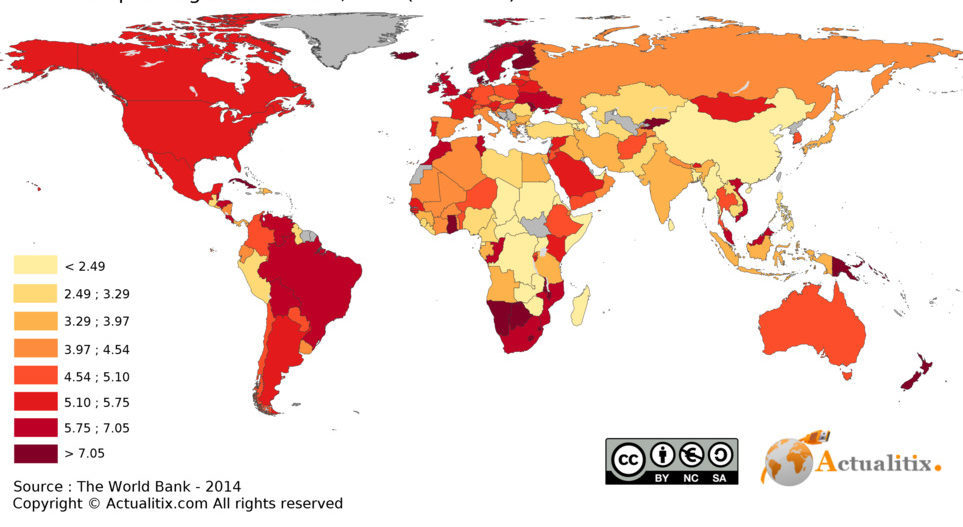
In this week’s wit and wisdom, Jyotirmoy Paul, a PhD student at the Indian Institute of Science, analyses the outlook of geoscience from the third world’s perspective.
 Academia has been shaped and influenced by the course of world history. The third world concept was seeded in Brussels, 1927, in a gathering of the League Against Imperialism1 and became popular in the mid-1950s through various Afro-Asian meetings, particularly in Bandung, Cairo, and Havana (1955, 1961, 1966)2. The history of the third world might be short, but it was enough to control the development of research, industry, and economics. It might also be essential to note that the third world was merely some geographical area, rather an ideology for a new world crafted by political leaders from Africa, Asia, Latin America, and Oceania after experiencing centuries of colonial oppression3. Being a geoscience researcher from the third world, I often explore the status and growth of this subject as well as the education system in my country and countries with similar conditions. Although arguments and analysis in this article will be mostly based on observation and experience from the Indian subcontinent, other third world countries may have similar conditions with slightly different scenarios.
Academia has been shaped and influenced by the course of world history. The third world concept was seeded in Brussels, 1927, in a gathering of the League Against Imperialism1 and became popular in the mid-1950s through various Afro-Asian meetings, particularly in Bandung, Cairo, and Havana (1955, 1961, 1966)2. The history of the third world might be short, but it was enough to control the development of research, industry, and economics. It might also be essential to note that the third world was merely some geographical area, rather an ideology for a new world crafted by political leaders from Africa, Asia, Latin America, and Oceania after experiencing centuries of colonial oppression3. Being a geoscience researcher from the third world, I often explore the status and growth of this subject as well as the education system in my country and countries with similar conditions. Although arguments and analysis in this article will be mostly based on observation and experience from the Indian subcontinent, other third world countries may have similar conditions with slightly different scenarios.
Perception of Geoscience

Figure 1. Number of participants per million population of a country attending EGU General Assembly 2019.
When I decided to study geology as my undergraduate, most of my relatives and friends thought this is “zoology” (sounds similar). Some recognised the subject as a part of geography. This perception of Geoscience is not very different in the rest of my country. Until high school education, students or their family members had rarely heard of this subject called geology, which is the most common subject of Earth system science taught at India’s undergraduate levels. In fact, geology is one of the most negligible subjects in the science discipline. For example, one of India’s oldest universities, the University of Calcutta, has only 5 of 160 affiliated colleges where geology is taught as an undergraduate course. In other leading institutes, the scenario is not very different. Among the 23 Indian Institutes of Technology, the premier institutes of India (some of them rank in the top 200 universities of the world), only 6 offer a geoscience course. To verify if such a trend is only valid in India or across all the third world countries, I calculated the number of participants per million population of a country attending EGU General Assembly 2019 and plotted them4. The result shows (Fig. 1) an evident pattern and probably indicates that the lack of popularity of geoscience is not unique in the Indian subcontinent but a pervasive issue across the third world. Here, I will put forward some of the points that might explain why geoscience is underdeveloped in the third world. This article is not the final answer to address all the problems, rather a first attempt to understand the outlook of geoscience and general education from the perspective of the third world.
Lack of leaders in geoscience
In these 300 years, the present third world was ruled by white imperial powers and impeded most of the native developments. Geoscience, being a very budding subject in this time, never got a chance to flourish in the third world…
One of the prime reasons that geoscience subjects are so unpopular is probably the lack of world leaders in this field from the third world. It is widely argued that geoscience is a white male-dominated community5, but the reason behind that is hardly analysed. If we look at the history of modern geoscience, it started developing during the 18-19th century and became more mature in the 20th century. In these 300 years, the present third world was ruled by white imperial powers and impeded most of the native developments. Geoscience, being a very budding subject in this time, never got a chance to flourish in the third world, which might be a reason we see a whiteness problem in geoscience.

Figure 2. Radhanath Sikdar, the Bengali mathematician who calculated peak fifteen to be the highest peak of the world.
However, many will argue that imperial powers introduced geoscience to their colonies. For example, the first college of geology in India was established at Presidency College, Calcutta (now Kolkata)6 under British rule. The Geological Survey of India was also founded during the British Raj, and extensive work was carried out, particularly during the Great Trigonometrical Survey7. However, such efforts did not produce any local leaders; instead, most native names were hidden behind the imperial masters. One prominent example is the forgotten Bengali mathematician Radhanath Sikdar (Fig. 2) who actually calculated Peak XV to be the highest peak of the world8, presently known by the name of retired survey officer George Everest.
In the post-colonial era, a significant amount of work has been done from third world countries. From India, several geoscientists have contributed fundamental knowledge to the subject. Sudipta Sengupta, Mihir Kumar Bose, Subir Kumar Ghosh, Kshitindramohan Naha, Birbal Sahni, K.S. Valdiya to name a few. However, these names become familiar only when a student comes to the field of geoscience, before that, most geoscientists remain aloof from society.
Economy and science
In demand for peace, bread, and justice, here education became a secondary priority; and geoscience, being one of the most neglected sciences, remained suffocated.
Figure 3. Expenditure of each country on their education from the total gross domestic product (GDP) in %. Data from the world bank, 2014, figure soruce: https://en.actualitix.com
As scientists, we may prefer to see science in a holistic approach, but science is a product of social forces arising from political and economic powers. The sophisticated instruments, human resources, and accessories required to produce quality science are essentially dependent on the economy. Even the publication fees for several top shot journals are so high that considerably good works are not submitted in these journals due to lack of proper funding. The map (Fig. 3) shows public expenditure of each country on their education from the total gross domestic product9. Indeed, third world countries are lagging. The colonial period has significantly reduced economic growth in the third world. Even after decolonisation the condition did not change overnight because the economic powerhouse was still controlled by the imperial powers. Edward Said argued, “Imperialism did not end, did not suddenly become ‘past’, once decolonization had set in motion the dismantling of the classical empires. Rather it remained one of the most powerful economic forces in the developing countries.”10 Also, after independence, the third world had to accept the new concept of “nation-state” that led to internal and borderline conflicts, eventually pushing them to secure more budget for defense and military. Important to note that after the devastating World War II, Europe was rebuilt by the Marshall plan that provided enough funds to restructure the university and education system11. On the other hand during post-colonisation, third world countries indeed got financial help from the world bank, but within a few decades the burden of interest grew exponentially and thus managed negligible capital for investing on basic science and university structure. In the demand of peace, bread and justice12, here education became a secondary priority; and geoscience, being one of the most neglected sciences, remained suffocated.
Outside the sphere of academic imperialism
Under this academic imperialism, the “outsiders” either struggle to enter into the imperial sphere or accept the academic world is essentially west-centric and migrate there.
Presently with the incident of George Floyd, the world is protesting in various ways. A large portion of knee-jerk reactions from the academic sector has died away within a few weeks or months or so. The hegemonic structure will be re-established, and subtle racist and sexist remarks will once again find its place in academia. After the #Blacklivesmatter, two big geoscience union bodies, the American Geophysical Union (AGU) and the European Geoscience Union (EGU), have released their anti-racism statements and have shown strong support for equality, diversity, and inclusion13, 14. A recent trend of #BlackInGeoscience has become very popular in this context15, and it has been branded and merchandised for further capital business16. However, all this social media activism remained confined again within the white world. The wave of #blacklivesmatter or #BlackInGeoscience is yet to reach the third world, and the discrimination based on the geographical territory will prevail. In the meantime, if the white population can show that they have created or attempted to create a homogeneous mixture of community within their geographical region, they may become oblivious to the rest of the world. This concept is not surprisingly new. History gives us thousands of examples of how whiter nations were obsessed with their worldview. The most famous example could be the usage of the word “World War”. That is how imperialist history taught us to see the world through the prism of whiteness, so we call war amongst white nations as “World War” where the rest of the world actually had no stake without some being used as colonial resources.
Similarly, the state of academic imperialism has created their own-world of knowledge in Euro-American territory, paving the way for hegemony and racism deep into the system. Unwritten documents and experiences could show how people from third world countries were discriminated against in the prestigious award ceremonies, publishing in so-called high impact journals, and even acknowledging the third world’s contribution to science. Under this academic imperialism, the “outsiders” either struggle to enter into the imperial sphere or accept the academic world is essentially west-centric and migrate there. The highly underdeveloped geoscience in the third world is in the early stage of this struggle to find its way.
Time on a move
Scientists prefer to live in an ivory tower of society. Holistically interpreting the essence of science and turning a face away from society has witnessed increasing pseudo-science propaganda and the demise of scientific temper worldwide. The recent trends of #blacklivesmatter, #Icantbreathe, #ShutDownAcademia, and #ShutDownSTEM17 movements have again shaken the thoughts of many scientists across the world to again look into the social issues. Although these movements are from the first world, progressive people are talking about the existing systemic racism and acknowledging discrimination. Statements from bodies like AGU and EGU also play crucial roles in creating awareness in the geoscience world. Yet, we have a long way to go until we witness a world free of discrimination. Time is on a move. Social changes do not come overnight. Until then, instead of fantasising only London-New York-Paris as centre for global development, Kinshasa-Kolkata-Caracas or Havana-Hanoi-Harare could bring a balance to the world.
Acknowledgment: Discussion with Manuj Mukherjee, Ishita Pal, Subhronil Mondal, and Anupam Samanta was really helpful. Thanks to Iris van Zelst for insightful feedback about the article.
Notes: 1 League Against Imperialism (LAI) was officially founded in Brussels, 1927. Apart from political leaders this league was also supported by prominent scientist Albert Einstein. http://www.open.ac.uk/researchprojects/makingbritain/content/league-against-imperialism 2 Three important conferences took place in the mid-1900s to conceptualise and unite third world. The Afro-Asian Conference, Bandung, 1955 (https://history.state.gov/milestones/1953-1960/bandung-conf); The Afro-Asian Women’s Conference, 1961 (https://www.worldcat.org/title/first-afro-asian-womens-conference-cairo); and The Tricontinental Conference, Havana, 1966 (https://www.thetricontinental.org/our-history/). 3 The Darker Nations: A Biography of the Short Lived Third World, Vijay Prasad, Leftword, pp: 13 4 Participants of the EGU General Assembly 2019: https://www.egu.eu/meetings/general-assembly/meetings/participants-2019/. Country wise population data was taken from United Nation database. 5 Earth Science has a whiteness problem: https://www.nytimes.com/2019/12/23/science/earth-science-diversity-education.html 6 Oldest Geology department in India was established in Presidency College, University of Calcutta, 1892: https://www.presiuniv.ac.in/web/geology.php 7 First geological map in India was produced during the great trigonometrical survey. Read more: https://www.gsi.gov.in/webcenter/portal/OCBIS/pageaboutus/pageaboutgsi 8 Everest: The Summit of Achievement, Stephen Venables, Royal Geographic Society, London, pp: 30 9 World Bank data for GDP expenditure, https://en.actualitix.com/country/wld/expenditure-on-education-in-the-world.php 10 Culture and Imperialism, Edward Said, 1994, Vintage, pp: 362 11 History of Marshall plan: https://www.marshallfoundation.org/marshall/the-marshall-plan/history-marshall-plan/ 12 The Poorer Nations: A Possible History of the Global South, Vijay Prasad, Leftword, pp: 1-13 13 A Statement on Anti-racism from Global Environmental Change Section, American Geophysical Union. https://connect.agu.org/gec/about/statement 14 EGU strongly supports equality, diversity and inclusion, https://www.egu.eu/news/661/egu-strongly-supports-equality-diversity-and-inclusion/ 15 #Black In Geoscience. EGU Geodynamics Blog, https://blogs.egu.eu/divisions/gd/2020/06/10/black-in-geosciences/ 16 Blackingeoscience t-shirt: https://teespring.com/stores/blackingeoscience 17 https://www.shutdownstem.com

